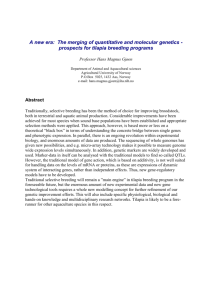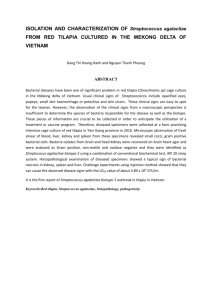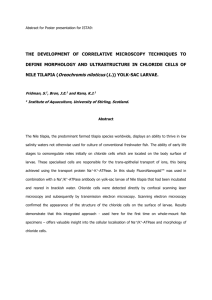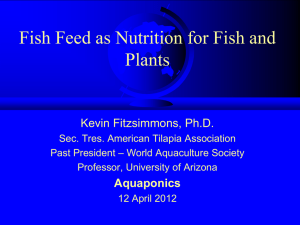Tilapia Aquaculture – An Overview: Nutrition
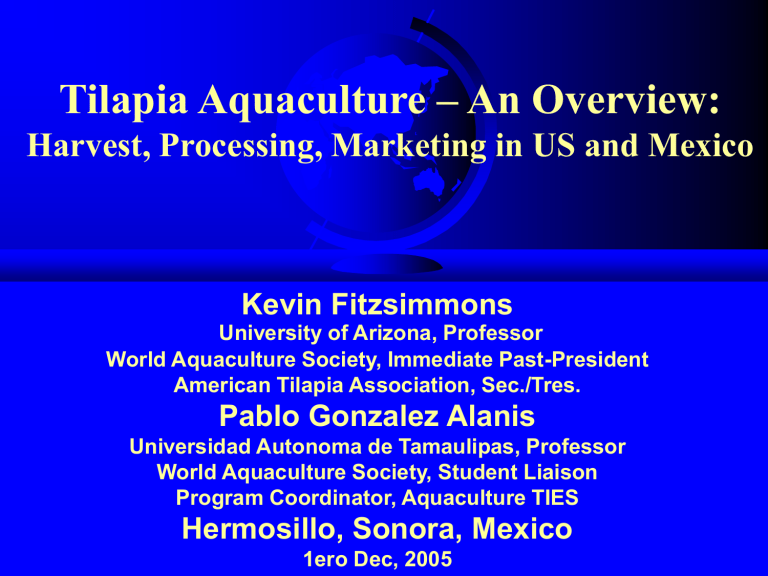
Tilapia Aquaculture – An Overview:
Harvest, Processing, Marketing in US and Mexico
Kevin Fitzsimmons
University of Arizona, Professor
World Aquaculture Society, Immediate Past-President
American Tilapia Association, Sec./Tres.
Pablo Gonzalez Alanis
Universidad Autonoma de Tamaulipas, Professor
World Aquaculture Society, Student Liaison
Program Coordinator, Aquaculture TIES
Hermosillo, Sonora, Mexico
1ero Dec, 2005
Tilapia aquaculture
Second most important farmed fish after the carps
Most widely grown of any farmed fish
In 2003 became the eighth most popular seafood in the US
In 2004 moved up to sixth most popular seafood in the US
Pre-processing steps
Hatchery and Growout
Check for off-flavor
Harvest techniques
Depuration
Transport to processor
Quality Control begins on the Farm
Farmer must remember that many actions during growout can affect final product quality and marketing
For example: some markets will not accept any hormone used on fish.
So sex-reversed fish may not be sold to these customers
“Organic” markets have whole set of requirements
Important on-farm management issues affecting markets
Sex-reversal (yes or no)
Feed supply (lowest cost, highest quality, organic)
Algae control to avoid off-flavor
In salt water, control parasites that might scar skin or impact fillet
Bird control (environmental issue, loss of stocks, vector for parasites and disease)
Decisions before harvest
Who will buy the fish?
Who will harvest the fish?
Is flavor of fish acceptable?
Testing by cooking fillet in paper bag in microwave oven. Trained taster needed.
Will depuration be needed? (at farm or processing plant)
How many days and who will test?
Fish should be transported live to processing site!
Transport to processing plant
Best to transport live
May want to add salt to reduce stress and maintain quality
Processing steps
Processing line
Bleeding / chilling stage
Scale removal
Deheading
Evisceration
Fillet
Skinning
Trimming
Processing steps
Processing line
Hand cutting, machine cutting, or mix
Most plants use a mixture of machine and hand
Need to make these basic decisions before starting plant.
Decide when and how to kill fish. (Chill, electric shock, bleeding or cutting head)
Before or after bleeding.
Bleed better before chilling.
Stay more fresh with faster chilling
Some prefer to kill before bleeding
Processing steps
Scale removal
Most processors use rotating drum de-scalers
Deheading
Most use food grade band saw
Some still cut by hand
Handlers should use chain mail gloves
Evisceration, by hand or vacuum
Hand evisceration – less investment, no equipment to malfunction or maintain
Vacuum – less labor, waste is concentrated in collection tank, less mess on line
Removal of skin, by hand or machine
Most plants use automated skinning
Most markets are requiring deep skinning, leaving more flesh on the skin
Skinners
Removal of pin bones and trimming
Fillets have small bones that must be removed for international markets
Buyers are requesting better trim of margins of fillets for more consistent appearance
Treatments, value-addition and packaging
Ozonated water baths
Carbon dioxide and Liquid Smoke
Freezing
Packaging
Multi-function machines
By-products
Processing - bacterial testing
Samples should be checked for bacterial contamination
Follow HACCP procedures and EU guidelines
Many plants are using ozone dips to reduce surface bacteria
Processing - fillet line
Blow drying fillets
Application of either:
“liquid smoke” or some other kind of preservative.
Carbon monoxide
(also called liquid smoke)
CO infuses into fillet and reacts with myoglobin
Fillet maintains fresh appearance for longer period
Carbon monoxide
Most plants in China appear to use carbon monoxide
Some gas in chambers others infuse in bags before freezing
Individual bags for frozen fillets
Vacuum sealing
Many forms of packaging
IQF Fillets in re-sealable packages
New product forms
Sashimi grade tilapia
Smoked tilapia
Hickory Smoked
Review-Rapid advances in processing and quality assurance steps
Depuration stage
Bleeding step
Deep skinning
Additional trimming
Ozone dips
Improved packaging
Value added product forms
Faster delivery
Mexico - 100,000 - 110,000 mt
Tilapia-shrimp farm in Sonora
Pond Tilapia farm in Tamaulipas
1,000,000
900,000
800,000
700,000
600,000
500,000
400,000
300,000
200,000
100,000
0
World Tilapia Production of
2,002,087 mt in 2004
Mexican Consumption of Tilapia
110,000,000 kg ≈ one kg/per capita/year
US consumption ≈ 0.3 kg/capita/year
Most Mexican consumption is domestic, few imports from China
Tilapia production in Mexico
Production in most states of Mexico
Most production in southern states
Veracruz has greatest production
Intensive in north, lake ranching in south
Repopulation of reservoirs
Problem with FAO definition of aquaculture
Tilapia-shrimp polyculture in seawater
Markets in Mexico
Raceway system
Strong domestic markets; on ice, fillets in grocery stores
All domestic consumption –
Exports are minimal.
Live markets in Mexico
Live markets (≈ 30 pesos/kg)
Established live markets in Guadalajara and
Mexico City
Need to develop live markets in other cities
(Asians are first customers)
May need to provide live tanks to retailers
(allows you to exclude competitors)
Fresh product markets in Mexico
Regional and local markets (15-20 pesos/kg)
Wide recognition across Mexico
110,000 MT annual consumption
Virtually zero exports, this is a prime opportunity
Frozen product markets in Mexico
Strong markets (10-15 pesos/kg)
Established channels for processing and distribution
Problem with frozen imports from China
Should be a temporary problem as costs rise in China and transportation costs increase
(Of course future change in costs in China does not help tilapia farmer in Mexico today)
Global Tilapia Sales
For year 2000
US $ 1,706,538,200
(FAO Fisheries Circular No. 886)
2005 sales >$ 3,000,000,000
2010 sales >$ 5,000,000,000
Top Ten Seafoods (U.S.) per capita (lbs)
2000 2001 2002 2003 2004 (est)
Tuna 3.5 Shrimp 3.4 Shrimp 3.7 Shrimp 4.0
Shrimp 4.2
Shrimp 3.2 Tuna 2.9 Tuna 3.1 Tuna 3.4
Tuna 3.4
Pollock 1.6 Salmon 2.0 Salmon 2.0 Salmon 2.2
Salmon 2.2
Salmon 1.5 Pollock 1.2 Pollock 1.1 Pollock 1.7
Pollock 1.7
Catfish 1.1 Catfish 1.1 Catfish 1.1Catfish 1.1
Cod 0.8 Cod 0.6 Cod 0.7 Cod 0.6
Catfish 1.1
Tilapia 0.7
Clams 0.5 Clams 0.5 Crabs 0.6 Crabs 0.6
Cod 0.6
Crabs 0.4 Crabs 0.4 Clams 0.5
Tilapia 0.54
Crabs 0.6
Flatfish 0.4 Flatfish 0.4
Tilapia 0.4
Clams 0.5
Clams 0.5
Scallops 0.3
Tilapia 0.35
Flatfish 0.3 Scallops 0.3
Scallops 0.3
Tilapia 0.28
US Tilapia Aquaculture
9,200 mt per year (20,000,000 lbs)
California is largest producer
ID, NC, FL, TX, AZ, NY,PA, MA are also significant producers
Virtually all tilapia in US for live sales
Asian groceries and restaurants are primary market outlets
Nutritional quality contributes to popularity
USDA has completed a complete highly technical nutritional analysis.
Now is preparing nutritional report on tilapia for the general public
New USDA “Pyramid” guidelines further support frequent fish consumption
Nutritional quality of tilapia contributes to popularity
Moderate in PUFA’s:
0.387 g/100g raw
0.600 g/100g cooked
Moderate omega 3 FA’s: 0.141 g/100g raw
0.220 g/100g cooked
Source – USDA- ARS Lab
Low in mercury: Tilapia = 0.01 ppm
Shark = 0.99 ppm
Source FDA http://www.cfsan.fda.gov/~frf/sea-mehg.html
US market development
The LAND opens at
EPCOT in 1983 – features tilapia culture and on menu in the Good Turn
Restaurant
Farms in ID, CA, FL &
AZ begin sales to Asian stores and restaurants
Farms in Colombia, Costa
Rica, Jamaica Taiwan, and
Indonesia begin imports
Market evolution in US
Ethnic buyers (Asians, Latino &
African)
Live markets
Up-scale restaurants
Casual dining
Club stores and hypermarkets
Local groceries
250,000
US Consumption of tilapia from domestic and imported sources
200,000
150,000
Domestic
Imports
100,000
50,000
0
US Tilapia consumption
412,148,000 lbs
(187,000 mt) of live weight-2003
504,716,000 lbs
(229,000 mt) of live weight 2004
250,000
200,000
150,000
100,000
50,000
0
1986 1988 1990 1992 1994 1996 1998 2000 2002 2004
19,480 mt fresh fillets, 36,160 mt frozen fillets,
57,2990 mt whole frozen (2004)
Tilapia product forms imported to the U.S.
120,000
100,000
80,000
60,000
40,000
20,000
0
Whole Frozen
Fillet Frozen
Fillet Fresh
$174,215,165 (2002) $241,205,610 (2003) $297,413,000 (2004) $ 352,305,388 (est 2005)
2002
$200,000,000
$450,000,000
$180,000,000
$400,000,000
Whole Frozen
Fillet Frozen
Fillet Fresh
$0
1993 1994 1995 1996 1997 1998 1999 2000 2001 2002
Whole Frozen
Whole Frozen
Fillet Frozen
Fillet Frozen
Fillet Fresh
Fillet Fresh
US Sales of tilapia
Imports in 2004 were $297,413,261
US production of $40,000,000 at farm
2004 Total US tilapia sales were over
$337,000,000
2005 Sales estimate –
$176,152,694
(Jan-June imports)
*2=
$352,305,388 + $40,000,000 =
$392,000,000
Current US Market Trends
Increase in demand for all forms of tilapia
Demand increase will be greatest for fresh fillets
Demand increase will be smallest for live tilapia
Tilapia the “Green” farmed fish
Herbivore / omnivore, low trophic level feeder
Algae, bacteria, and detritus are important food sources
Prepared feeds are mostly grains and ag byproducts
Can be reared in high densities, with low water exchange
Disease resistant and tolerant of poor water quality. Anti-biotics and chemicals are rarely used.
The “environmental” fish
Promoted by aid agencies and NGO’s
Dr. M. Gupta wins World Food Prize for promotion of tilapia aquaculture, June 10, 2005
Does not prey on other species
Often used in integrated farming systems
Frequently reared in reservoirs and irrigation systems with effluents used for irrigation, reducing fertilizer applications
4
3
6
5
2
1
0
Tilapia Market Trends
7
Prices have been constant or trending down for several years, will not increase with inflation
Fresh fillet
Frozen fillet
Whole
Live
Global aquaculture production of tilapia
Aquaculture Fishery
3,000,000
2,500,000
2,000,000
1,500,000
1,000,000
500,000
0
Year
Advertising at all levels
Advertising
Cooking contests and gastronomic festivals
Tilapia by-products
Leather goods from skins
Pharmaceuticals from skins
Formed fish products
Fertilizer
Fish meal
Tilapia Leather
Flowers made from Tilapia scales
Future global tilapia production
3,000
2,500
2,000
1,500
1,000
500
0
